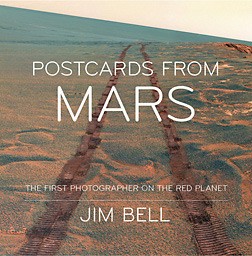NASA's red planet 'photographer' Jim Bell presents 'Postcards From Mars' in art book about space
By Lauren Gold
On Earth, Cornell astronomer Jim Bell says, he is an amateur photographer at best. But "I've always been drawn to landscapes," he says.
That's a good thing. These days he finds himself accumulating a lot of them: 160,000, actually, taken by two tireless faraway helpers called Spirit and Opportunity over the last two-and-a-half years.
Bell, associate professor of astronomy at Cornell and leader of the Pancam color camera team for NASA's Mars Exploration Rover mission, is head of a giant team of thousands, from senior scientists to diligent undergraduates, who have received and processed images from the two rovers since they landed on Mars in 2004.
Bell is now also author of a new genre-defying book, "Postcards From Mars" (Dutton), which comes out in bookstores – including the Cornell Store – Nov. 16.
"Postcards" is heavy, sleek, eye-catching – complete with fold-out panorama shots, vivid landscapes and close-ups of some of the mission's most important scientific finds. It's also a comprehensive narrative – in words and pictures – of the mission.
Some of the book's 100-or-so images are Mars as a human (about the height of a 10-year-old) would see it. Others dress the planet up in false color – each variation in texture or soil composition accentuated in weird, Andy Warhol-ish hues.
Some of Mars' true colors, though, are even weirder. The sunset, for example.
"It's dramatically different from what you see on the Earth," says Bell. "The sun's a lot smaller, because we're 50 percent farther away. And the colors of the sky are kind of backwards from the Earth's sky colors. ... On Mars, most of the time the sky is these beautiful shades of orange, red and brown. But as the sun sets, the way the dust scatters light, it really likes to scatter blue light forward ... which is exactly the opposite of what we're used to seeing.
Jim Bell will sign copies of "Postcards From Mars" Nov. 30 from 11:30 a.m. to 1:30 p.m. at the Cornell Store. That evening, from 7 to 8:30, he will give a presentation at the Ithaca Sciencenter, followed by a book signing.
"It's beautiful," he says. "There's some amazing scientific information there about the properties of the dust. But ... I just get captivated by the beauty of it."
Deciding which images to include in the book – and which to leave out –- was tough. ("Asking me to choose a favorite image is like asking a parent to choose a favorite child," Bell says.) But deciding to write the book in the first place was easy.
"We knew we'd be going to some amazing places, different than we'd ever been before, and seeing landscapes and vistas that humans had never seen before," he says. "And we felt, all of us on the team, a responsibility to communicate that and to portray that in a way that made it ultimately very human and very personal.
"I really wanted people to look at this book and say, 'Wow, it's an art book about space.' Not a space book, but an art book. There's an enormous amount of beauty, as well as the science, in these kinds of explorations."
And while much of the world's news seems depressing these days, Bell says, he hopes the book makes the point – especially to the youngsters who will be the next generation of scientists and explorers – that some pretty incredible things are going on as well.
"These missions ... they're a really positive thing," he says. "There really are great things happening today. They're hard to find ... but they're out there. And these little rovers, and the incredible people that designed them and built them and operate them and that I'm fortunate enough to work with, are doing amazing things. So here's a little piece of that pie."
Media Contact
Get Cornell news delivered right to your inbox.
Subscribe